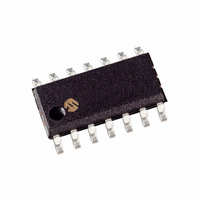PIC16F506-I/SL Microchip Technology, PIC16F506-I/SL Datasheet - Page 43

PIC16F506-I/SL
Manufacturer Part Number
PIC16F506-I/SL
Description
IC PIC MCU FLASH 1KX14 14SOIC
Manufacturer
Microchip Technology
Series
PIC® 16Fr
Datasheets
1.PIC12F510-ISN.pdf
(124 pages)
2.PIC16F506-ISL.pdf
(12 pages)
3.PIC16F506-ISL.pdf
(8 pages)
4.PIC16F506-ISL.pdf
(22 pages)
5.PIC16F506-IP.pdf
(114 pages)
Specifications of PIC16F506-I/SL
Program Memory Type
FLASH
Program Memory Size
1.5KB (1K x 12)
Package / Case
14-SOIC (3.9mm Width), 14-SOL
Core Processor
PIC
Core Size
8-Bit
Speed
20MHz
Peripherals
POR, WDT
Number Of I /o
11
Ram Size
67 x 8
Voltage - Supply (vcc/vdd)
2 V ~ 5.5 V
Data Converters
A/D 4x8b
Oscillator Type
Internal
Operating Temperature
-40°C ~ 85°C
Processor Series
PIC16F
Core
PIC
Data Bus Width
8 bit
Data Ram Size
67 B
Maximum Clock Frequency
20 MHz
Number Of Programmable I/os
12
Number Of Timers
1
Maximum Operating Temperature
+ 85 C
Mounting Style
SMD/SMT
3rd Party Development Tools
52715-96, 52716-328, 52717-734
Development Tools By Supplier
PG164130, DV164035, DV244005, DV164005, PG164120, ICE2000
Minimum Operating Temperature
- 40 C
On-chip Adc
3-ch x 8-bit
Lead Free Status / RoHS Status
Lead free / RoHS Compliant
Eeprom Size
-
Connectivity
-
Lead Free Status / Rohs Status
Lead free / RoHS Compliant
Available stocks
Company
Part Number
Manufacturer
Quantity
Price
Company:
Part Number:
PIC16F506-I/SL
Manufacturer:
MICROCHIP
Quantity:
16 700
Company:
Part Number:
PIC16F506-I/SL
Manufacturer:
Microchip Technology
Quantity:
33 360
Part Number:
PIC16F506-I/SL
Manufacturer:
MICROCHIP/微芯
Quantity:
20 000
6.1
When an external clock input is used for Timer0, it must
meet certain requirements. The external clock require-
ment is due to internal phase clock (T
tion. Also, there is a delay in the actual incrementing of
Timer0 after synchronization.
6.1.1
When no prescaler is used, the external clock input is
the same as the prescaler output. The synchronization
of an external clock with the internal phase clocks is
accomplished by sampling the prescaler output on the
Q2 and Q4 cycles of the internal phase clocks
(Figure 6-4). Therefore, it is necessary for T0CKI or the
comparator output to be high for at least 2T
small RC delay of 2Tt0H) and low for at least 2T
(and a small RC delay of 2Tt0H). Refer to the electrical
specification of the desired device.
FIGURE 6-4:
6.2
An 8-bit counter is available as a prescaler for the
Timer0 module or as a postscaler for the Watchdog
Timer (WDT), respectively (see Figure 10-12). For sim-
plicity, this counter is being referred to as “prescaler”
throughout this data sheet.
The PSA and PS<2:0> bits (OPTION<3:0>) determine
prescaler assignment and prescale ratio.
© 2007 Microchip Technology Inc.
Note:
Note 1: Delay from clock input change to Timer0 increment is 3T
External Clock/Prescaler
External Clock Input or
Increment Timer0 (Q4)
Using Timer0 With An External
Clock
Prescaler
Output After Sampling
2: External clock if no prescaler selected; prescaler output otherwise.
3: The arrows indicate the points in time where sampling occurs.
EXTERNAL CLOCK
SYNCHRONIZATION
The prescaler may be used by either the
Timer0 module or the WDT, but not both.
Thus, a prescaler assignment for the
Timer0 module means that there is no
prescaler for the WDT and vice-versa.
Prescaler Output
in measuring the interval between two edges on Timer0 input = ±4T
TIMER0 TIMING WITH EXTERNAL CLOCK
Timer0
(2)
Q1 Q2 Q3 Q4
(3)
OSC
) synchroniza-
OSC
(1)
(and a
OSC
Q1 Q2 Q3 Q4 Q1 Q2 Q3 Q4 Q1 Q2 Q3 Q4
T0
When a prescaler is used, the external clock input is
divided by the asynchronous ripple counter-type
prescaler, so that the prescaler output is symmetrical.
For the external clock to meet the sampling require-
ment, the ripple counter must be taken into account.
Therefore, it is necessary for T0CKI or the comparator
output to have a period of at least 4T
RC delay of 4Tt0H) divided by the prescaler value. The
only requirement on T0CKI or the comparator output
high and low time is that they do not violate the
minimum pulse width requirement of Tt0H. Refer to
parameters 40, 41 and 42 in the electrical specification
of the desired device.
6.1.2
Since the prescaler output is synchronized with the
internal clocks, there is a small delay from the time the
external clock edge occurs to the time the Timer0
module is actually incremented. Figure 6-4 shows the
delay from the external clock edge to the timer
incrementing.
When assigned to the Timer0 module, all instructions
writing
MOVWF 1, BSF 1, x, etc.) will clear the prescaler.
When assigned to WDT, a CLRWDT instruction will clear
the prescaler along with the WDT. The prescaler is
neither readable nor writable. On a Reset, the
prescaler contains all ‘0’s.
OSC
to 7T
PIC12F510/16F506
to
OSC
OSC
T0 + 1
TIMER0 INCREMENT DELAY
. (Duration of Q = T
the
max.
TMR0
register
OSC
T0 + 2
Small pulse
misses sampling
). Therefore, the error
DS41268D-page 41
OSC
(e.g.,
(and a small
CLRF 1,


















